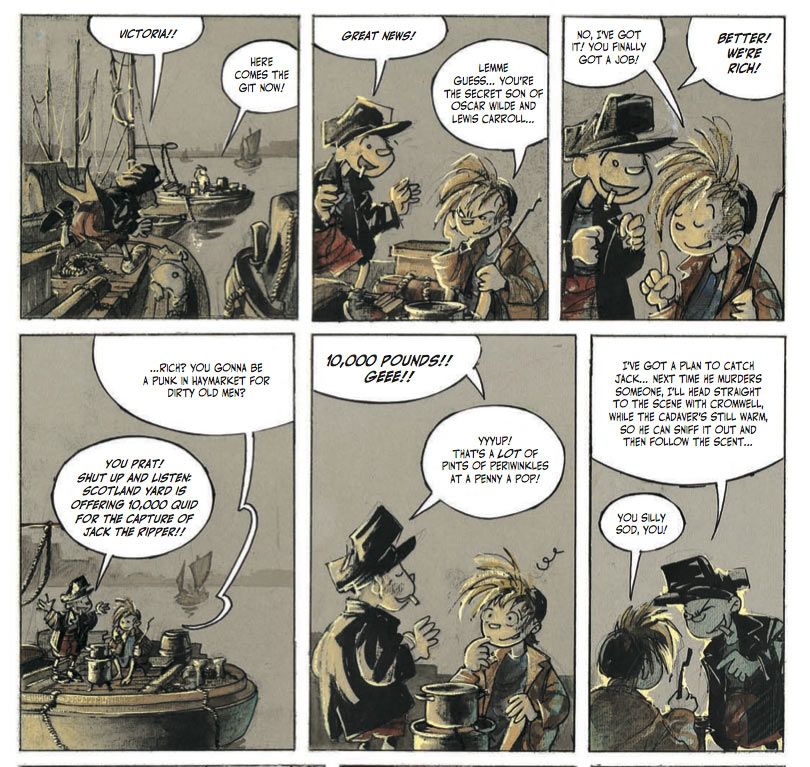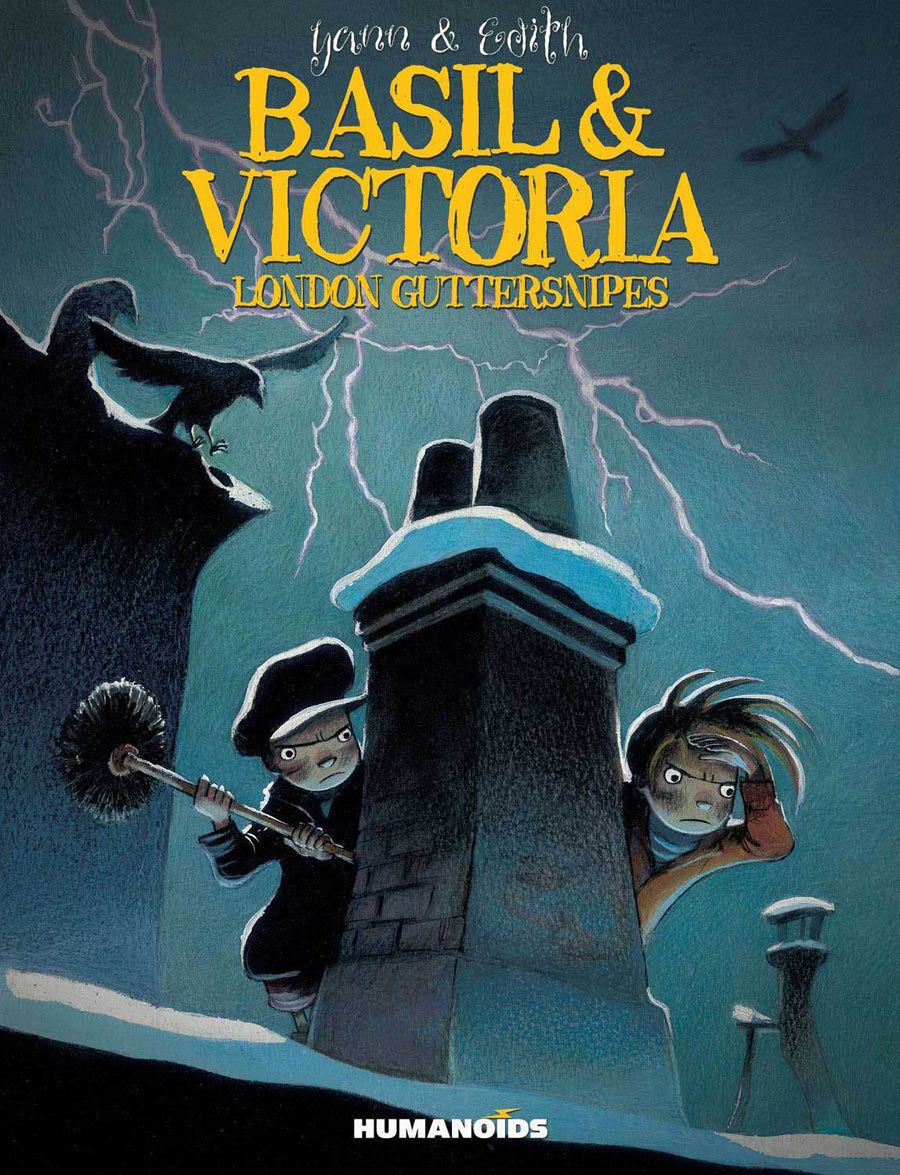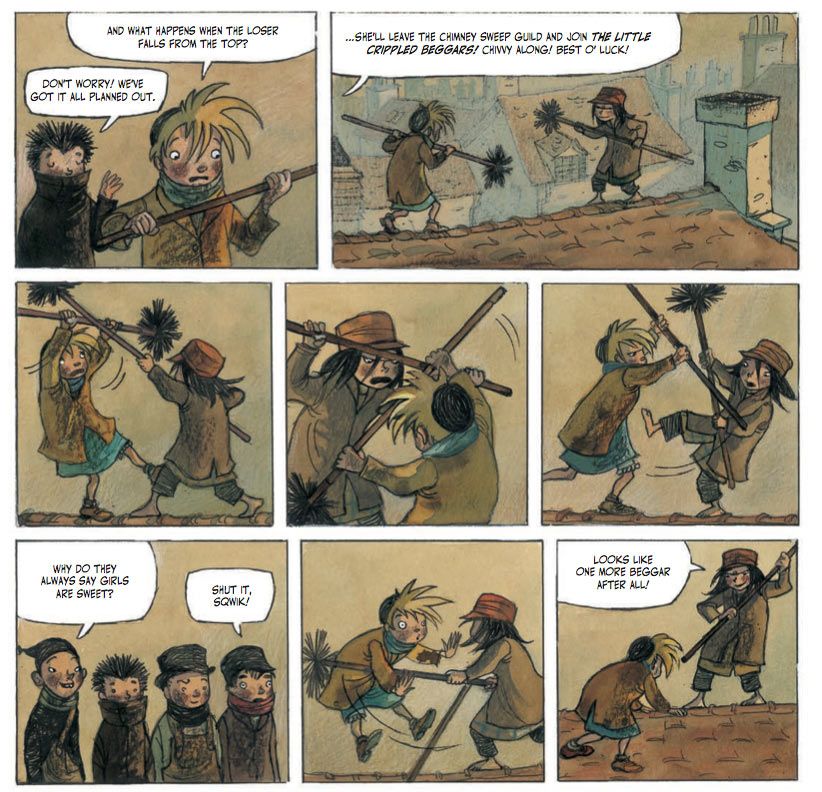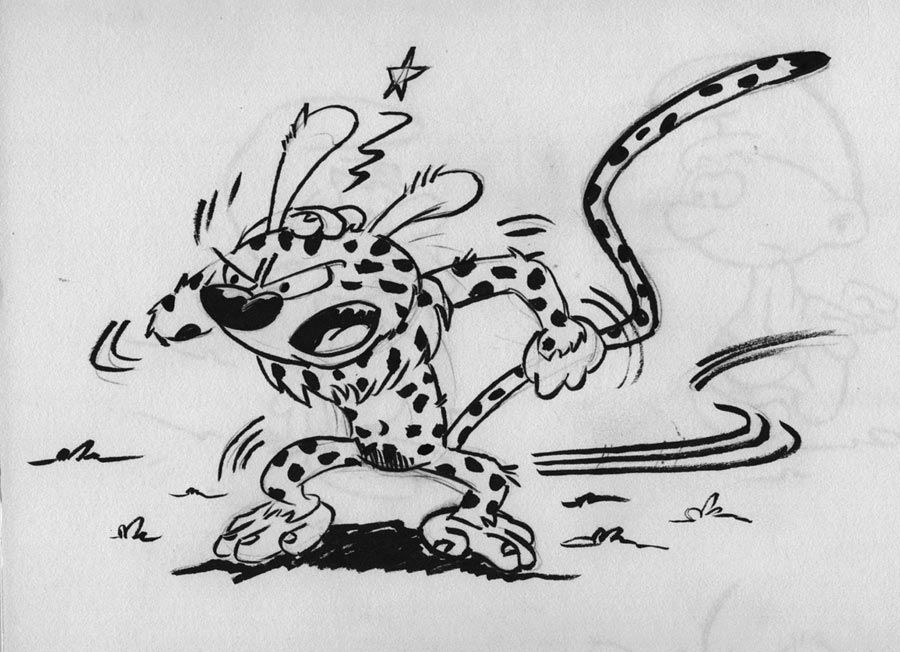BASIL AND VICTORIA: LONDON GUTTERSNIPES
When a publisher does such a good job describing their series, I see no need to attempt rewriting it myself. This is how Humanoids describes "Basil & Victoria: London Guttersnipes":
London, 1887. While the British Empire is at its peak, and influences the majority of the world, most of London still lives amid poverty, disease, and crime. Basil and Victoria are two of the thousands of orphaned street urchins who survive by hustling, selling rats, and sleeping on the docks. Helped by Cromwell, their faithful bulldog, the trio travel from the mean streets of Whitechapel to exotic distant lands, meeting famous, and infamous, historical and literary figures along the way, as they lovingly bicker and squabble the entire time!
Two things immediately stand out about this book.
First, the art is by the singly-named Edith (short for Édith Grattery), who handles both the final art and the color work. In the first two chapters, in particular, it's a beautiful look at the grimey side of London in a dark time, with a technique that mixes strong textures with the colors. I'm not sure if its crayons, charcoals, or colored pencils, but it looks amazing. Her art, at first glance, is cartoonish, along the same lines as a Lewis Trondheim, but mixed with beautiful detailed architectural backgrounds that give the book a strong setting. The back alleys of London are filled with interesting buildings, dirty side rooms, and murky wharves. The browns and grays that dominate the book aren't overwhelming. They help to set the scene of a dirt poor city as seen from the seediest parts of it by two spunky kids forced to collect rats for pay to feed themselves.
The third and fourth books in the series move the action to the sea, Zanzibar, and Scotland. It becomes a far brighter book, and the overloaded grimness of the art warps into something else. The cartooning stands out more than the coloring technique. Some sequences seem downright simple. But Edith continuously returns to the roots of the book with painterly backgrounds. Even in simple scenes where it's characters acting out against a sparse backdrop, the coloring adds some textured gradients without being that school of Photoshop that at times dominated comics in the 90s. (The third book was done in 1995. The fourth and fifth books weren't done until more than a decade later.)
The fifth book is back to grimey stories in poor London, now starring a gang of chimney sweeps. Edith has a chance here to add lots more black ink to the page and does so in spades. Between the chimneys and the black crows that dominate this story, the final look is a return to the form of the first two books. The story also feels more action packed, with lots of high rooftop action and fighting that give the book an extra few thrills along the way.
The other standout is that it incorporates many of the well-known names of the time you'd expect without being corny. The scripts by Yann (short for Yannick Le Pennetier) are smart. They're clever without being obvious. It's part of the book's character to be set in the real world of its time, and also include famous historical characters, both real and fictional. Sherlock Holmes is referenced, but Watson actually makes a (memorable and hilarious) appearance. Charles Dickens, whose name is synonymous with this genre of storytelling, makes an appearance. The second volume, "Jack," does of course star the serial murderer you were expecting. Thankfully, I remembered just enough of "From Hell" to laugh at some of the historical facts and how they blended them into this story so seamlessly. It's an alternate take on the mystery that fits perfectly into the character of the series and still manages to evoke a few chuckles between the gruesome murders. Deservedly so, the Jack the Ripper story won "Basil and Victoria" the Best Album prize at Angouleme in 1993.
The core of the series, though, is the relationship between the two title characters, who are doomed to be stuck with each other forever. There are obviously unrequited feelings there for each other that neither will ever really admit to, but it keeps them together even when going their separate ways seems like a better idea. They're both, on the surface, hard-bitten street kids who can wheel and deal to keep themselves alive. They're scrappy fighters who've lived through many lifetimes' worth of crap already, and Yann doesn't resist piling more on them, particularly in the first book, which features a related death or two that will surprise you, I think. There's no cheating for the sake of a happy ending, and characters don't suddenly act in the best of human nature for the sake of a clean story.
While Victoria's feelings for Basil come out to the surface more, Basil is a typical boy. It's always "hurt the one you love," right? He does that by being the Ladies Man. He flaunts it in front of Victoria, even when it's clearly not appealing to him. He makes a show of it. He loves taunting Victoria, but he's also a dumb enough boy that he doesn't realize what he's doing or see the obvious happening in front of him. The five book series ends without concluding this, as it should. They're still too young to properly sort that all out. Let us, as readers, delight in the awkwardness that the stories have because of it.
Besides the characters, there's also a lot of historical detail strewn throughout the book. A series of footnotes help explain some of the slang terms and historical moments that are brought up. The book isn't always pretty, as Victorian England, itself, wasn't by today's standards. Class, racial, and sexual division were a normal part of life. And, it would seem, the sailors in Her Majesty's service were usually thought to be gay. It's a repeated gag, but it's also played against type as much as it's played to type. The double standards inherent in women selling their bodies as opposed to men doing it come to light in a couple of cases that show it well.
Obviously, this isn't a book for kids. There aren't many swear words, but it's a mature book, particularly in handling the sexual situations, some of the violent moments, and the questionable language of the day. Again, the issues of racism and classism are handled straight on with direct language. Unless you want to start explain that to your youngest right away, this isn't the book for them.
This wouldn't surprise fans of Yann who might have previously read any of his "Les Innommables" series, a volume of which I picked up at a San Diego convention a decade ago. The art by Didier Conrad is stunningly cartooned, but the story is a brutal combination of sex and violence that I'm not sure would translate well to an American audience, no matter how hard a translator worked to smooth things over. The series originally started in Spirou Magazine, but didn't last long because it was too adult for that magazine. (Conrad, I should mention, just drew the latest "Asterix" book. His style is a perfect fit.)
But if you know Yann for his work on books like the Lucky Luke spin-off, "Kid Lucky," or "Freddy Lombard," or his "Marsupilami" stories, it might be a different story. You just can't peg some people into pigeon holes sometimes.
In any case, "Basil & Victoria" is a charming collection of stories. Beautifully illustrated and intricately plotted, the book is satisfying if occasionally troubling. (That was a nasty period of time that none of us would ever want to live in.) The art is beautiful, though the middle plateaus for a bit. And just when it ends, you feel like you've become familiar with the characters and want to pick up another volume right away. Sadly, there is no such thing.
"Basil & Victoria: London Guttersnipes" is out from Humanoids later this month. It will be a 240 page hardcover book at 8.5 x 11 inches in full color for $40. That's five European albums for eight bucks a pop at full price. That's a deal.
Fun side note: The series turned into an animated series for French television in the late 90s, after the first three books were published. It lasted 26 episodes. It also took on a new name, "Orson et Olivia." Here's the Christmas episode. That theme song is awful. The series is obviously brighter than the book, but the character designs and some of the painted backgrounds fit right in with the comics. Edith, herself, worked on the series. Maybe that helps explain part of the large publishing gap between books three and four...
WHAT WILL DARK HORSE DO?
Dark Horse announced the long-expected separation of the Star Wars license from their grasp. Marvel will have it starting a year from now, which immediately brings up another round of lunacy as people start making assumptions as to what Marvel will do with the license. It's assumed it'll be the big name Marvel creators working on the book. It's assumed there will be crossovers with Marvel characters. People are already lamenting the loss of a spotlight for up and coming talent, the way Dark Horse used the license. All of that might happen eventually, but it's far too soon to tell or assume what Marvel's plans are. I'm sure Marvel is working on plans now, but I'm betting that's not something they'd talk about until San Diego this summer, at least.
Or, as Graeme McMillan points out, the whole thing might fizzle out like all the other properties Marvel grabs the license to. You can even add CrossGen to that list.
What does this mean for Dark Horse? The licensed comics game -- which they pioneered in many ways -- has been their bread and butter for a long time. With a big chunk of their publishing program ripped out from under them, it might be time to rethink their business plan a little. I'd love to see them focus more on the creator-owned side of things. They've always been strong with creator-owned work aimed at Hollywood -- see "Hellboy" or "The Mask" or "Sin City." Dark Horse could reach out to those thinking about Image and try to woo them over with bigger promises of Hollywood stardom (and slight editorial guidance) in exchange for some kind of cut of the movie deal.
Or, perhaps they could go the European route. "Blacksad" seems to be a hit for them. They've released a series of Milo Manara volumes. What other European comics are waiting to be translated?
Or, they'll just find more video games to license out and create best-selling art histories of. We'll see. Again, by the time San Diego comes around, we should see what they have in mind.
EUROPEAN-THEMED PIPELINKS
- Bleeding Cool has the annual breakdown of sales in the Franco-Belgian comic book market. While "Asterix" dominates, there's plenty of other interesting numbers to ruminate over. In some ways, the European market isn't much different from the North American one. The dominant books are in long-running series, including new volumes of "Blake and Mortimer," "Thorgal," "Boule et Bill," and "XIII". Happily, new North American favorite "Blacksad" sold 220,000 copies of its new fifth volume. Let's hope Dark Horse brings that over quickly. "The Walking Dead" sells in the six figures for its collected editions. The French digital market is growing, and lots of movies and television series are based on their comics. Yeah, in many ways we're not that different...
- The biggest comics industry story in 2013 that got overlooked is the way comiXology spread out into Europe, going so far as to open an office in France. They're serious about it, and now have over 400 titles ready to purchase. They're still in French, but at least they're available in North America. The selection is tentative, as these new media outlets tend to be. "Titeuf" seems to be the biggest name in the store at the moment. I hope there's a wider variety of titles coming, and I hope work is put into translating more of these works into English. There's a bag of money on the side of the road for that one. . .
- I made my annual post-Christmas Amazon order this week. I'm looking forward to getting the new "Asterix" book, the second "Benny Breakiron" book, the fifth volume of "Spirou and Fantasio" which features Marsupilami, and Marvel's "Hawkeye" hardcover.
- When I need a break from drawing Smurfs, I go to Marsupilami, whose proportions come a bit more naturally to me.
DO SOMETHING
This is a general life lesson, but important nonetheless and easily related to comics: The tech blog, Rands in Repose, reminds us all of "The Builder's High" in a post that should be enough to spark a thousand lights and quiet down a lot of social networks. Here's the finale:
Turn off those notifications, turn your phone over, turn on your favorite music, stare at your blank slate and consider what you might build. In that moment of consideration, you're making an important decision: create or consume? The things we're giving to the future are feeling increasingly unintentional and irrelevant. They are half-considered thoughts of others. When you choose to create, you're bucking the trend because you're choosing to take the time to build.
After reading that blog entry, I started and finished a small programming project I had put off for weeks, wrote the first draft of a tutorial I wanted to do for another site, and started reading some comics in preparation for this column.
I plan on reading that blog post once a week this year to remind me to be more productive.
Twitter || E-mail || Pipeline Message Board || VariousandSundry.com || AugieShoots.com || Original Art Collection || Google+




